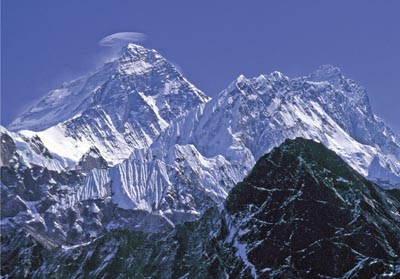Getting Out: As a young man, I immersed myself in stories of the
1963 American Everest Expedition. At the time, the mountain had
only been climbed three times, and an expedition required a massive
logistical effort that resembled a lengthy military campaign. There
was plenty of drama.
As a young man, I immersed myself in stories of the 1963 American Everest Expedition. At the time, the mountain had only been climbed three times, and an expedition required a massive logistical effort that resembled a lengthy military campaign. There was plenty of drama. On the first day in the Khumbu icefall, John Breitenbach died when an ice serrac as big as a railroad car collapsed on him. The climber in front of him and the one behind could only cut the rope and walk back to base camp. But in the end, the Americans put six men on the summit, two up the unclimbed West Ridge who then traversed the mountain and descended via the South Col – an amazing accomplishment.
Everest has always danced my imagination. I do not have the stuff to climb the mountain, but I have always longed to walk near it. Two weeks after Sept. 11, I boarded a plane bound for Kathmandu and the fulfillment of a lifelong desire.
I traveled with my sister and her friend who had been there before and knew a reputable outfitter. After being turned back by bad weather for two days, our plane was finally able to land on the short airstrip etched into the mountains at Lukla (9,350 feet). With two porters and a guide, we set out.
The early portion of the trail follows the Dudh Kosi (a river) through lush lowland villages with terraced fields giving no hint of the icy majesty ahead. Yak trains and porters shod only in flip-flops carried massive loads. The trail is the only supply line to the villages above.
We climbed 2,000 feet to Namche Bazaar, the hub of the Khumbu region, and entered the world of Himalayan Peaks. The next 10 days were a succession of sights and experiences that surpass the power of words and photography. The immensity of the mountains most impressed me in the afternoon when clouds came up the valley and hid them from sight. Then, way up, incredibly high, surely beyond the reach of anything earth bound, a small break in the clouds opened for a moment and revealed – I just couldn’t believe it – an icy mountain wall.
One highlight among so many was the view of Everest from Gokyo Ri. At sunrise, we left the village of Gokyo (15,584 feet) for the 2,000-foot climb to Gokyo Ri for the best view of Everest. The weather there at 17,519 feet was mild and still – a perfect day. The view was unobstructed, and the moment awe-inspiring. My childhood hope was fulfilled … almost.
Years after the death of John Breitenbach, the Khumbu Icefall released his body, and he was buried near the Tengboche Monastery. As we turned toward home, we entered Tengboche, and I asked where he rested. I looked without luck until I noticed some prayer flags strung from bushes well off the beaten track. There he was: “John Breitenbach 1935-63 AMEE ‘Long Live the Crow.'” Why way over here? Then I turned around and saw that he had a perfect view of the summit of Everest.
If you have an inkling for such an adventure, I encourage you to do it. If you are used to backpacking, trekking is luxury. With a porter, you only carry a light day pack over a short distance each day. Your experience will be much richer if you work with an outfitter in Kathmandu rather than going with a domestic trekking company. I struggle with altitude, but if you respect the prescribed schedule for acclimatization, you will be fine. It’s not the Hilton, but the inconveniences are small, and the rewards are … sorry, I don’t have the words.










